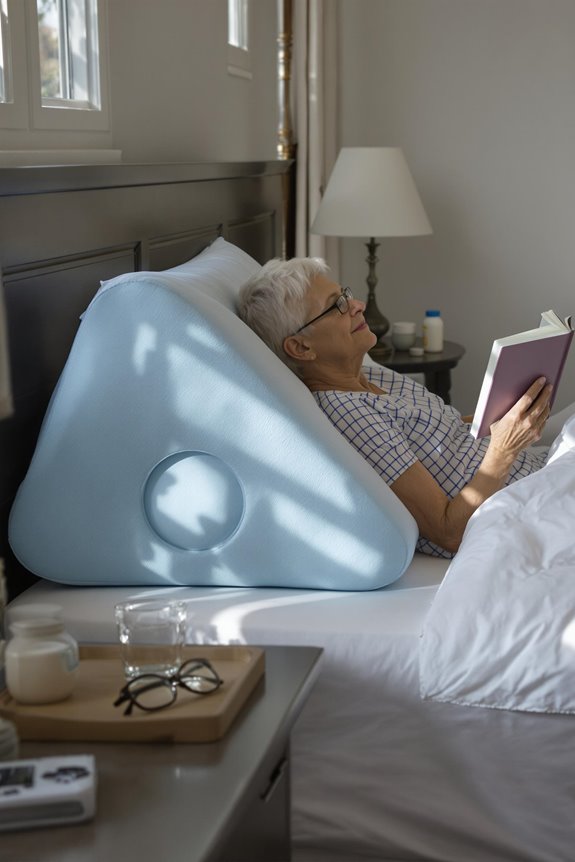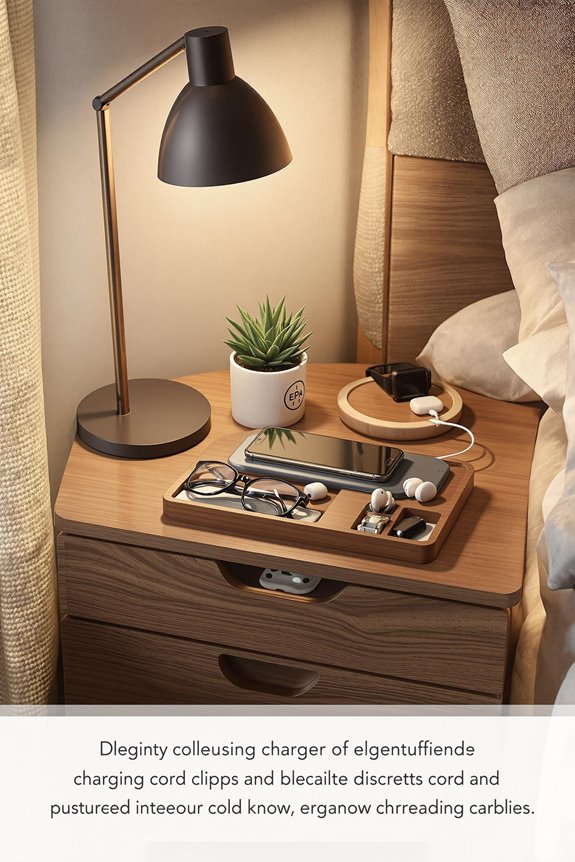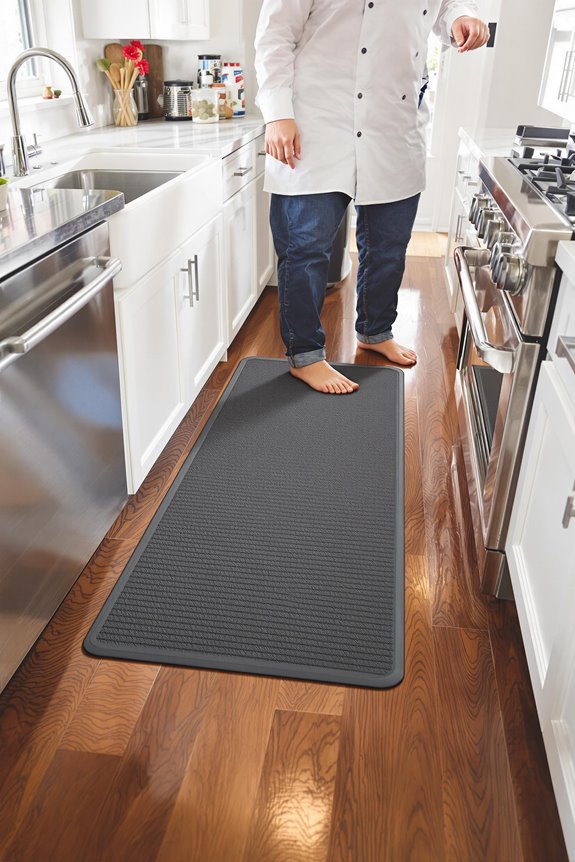You’ve likely experienced that moment of panic when you can’t remember if you turned off the stove. Automatic shutoff devices offer a simple solution to this common kitchen worry, particularly for seniors living independently or anyone juggling multiple responsibilities while cooking. These safety tools detect when a stove has been left unattended and automatically cut the power, preventing potentially devastating kitchen fires. But which features matter most for your specific situation?
Key Takeaways
- Automatic shutoff devices use motion sensors to detect when cooking is unattended and cut power to prevent kitchen fires.
- These safety devices are particularly crucial for seniors with memory concerns or those easily distracted while cooking.
- Installation costs range from $150-500 for basic models, with professional installation adding approximately $100-150.
- Monthly maintenance includes testing the device, checking sensor positions, and ensuring reset buttons remain accessible.
- Alternatives include induction cooktops, timer-based alert systems, and smart home monitoring systems for those concerned about kitchen safety.
Automatic Stove Shutoff Devices

Automatic stove shutoff devices have become essential safety tools for seniors who wish to maintain their independence while cooking at home. These devices monitor cooking activity and automatically turn off the stove when potentially dangerous situations arise, such as when a burner has been left on too long without attention.
Modern automatic stove shutoff devices use various technologies including motion sensors, timers, and temperature monitors to prevent kitchen fires. They’re particularly valuable for seniors with memory concerns or those who might become distracted while cooking.
Today’s stove safety technology offers peace of mind for families concerned about aging loved ones living independently.
Installation is typically straightforward, with many models simply plugging into existing outlets or mounting directly to the stove.
When selecting automatic stove shutoff devices, look for models that balance safety with ease of use, avoiding complicated interfaces that might frustrate older adults.
What it is and the daily problems it solves
These clever safety devices answer a question many of us worry about: “Did Mom leave the stove on again?”
At its core, an automatic stove shutoff device is a smart monitor that prevents kitchen accidents before they happen. The device detects when a stove has been left unattended and automatically cuts power after a preset time period.
This solves several daily challenges for aging parents living independently, including memory lapses, distractions, and fatigue that might lead to forgotten cooking.
For many families, these devices provide invaluable peace of mind while preserving a senior’s dignity and independence. Rather than constantly checking in or taking over cooking duties, you’re enhancing home safety without disrupting your loved one’s routine.
The technology works silently in the background until the exact moment it’s needed.
Who benefits and when to use it

Safety devices like automatic stove shutoffs offer tremendous benefits for aging parents who wish to maintain their independence while addressing specific concerns.
These systems are ideal for seniors who occasionally forget active burners, have limited mobility that makes quickly responding to kitchen emergencies difficult, or anyone experiencing mild cognitive changes affecting attention span or short-term memory.
Automatic stove shutoffs provide essential protection for seniors with memory lapses, mobility issues, or mild cognitive changes.
They’re particularly valuable for seniors living alone or those who frequently cook throughout the day.
Consider installing these devices when you’ve noticed:
- Burnt pots or pans
- Smoke alarms triggered by cooking
- Burners left on after meal preparation
- Increasing anxiety about kitchen safety for seniors
Many families introduce shutoff systems as a preventative measure before a serious incident occurs, providing peace of mind for everyone involved.
Key features to look for
Let’s look at what makes an automatic stove shutoff device truly effective for your loved one’s kitchen safety.
Shopping for these devices can feel overwhelming with so many options available today.
I’ve created a simple feature checklist to help you identify the right solution that matches your parent’s specific needs and kitchen setup.
Feature checklist
When shopping for automatic stove shutoff devices, five essential features can make all the difference in both safety and usability.
Look for systems with motion detection technology that recognizes when someone’s at the stove versus when it’s unattended. This contributes greatly to fall prevention by eliminating the need for seniors to rush back to the kitchen when they’ve forgotten something.
- Easy installation without requiring complex electrical work or permanent modifications to the existing stove
- Adjustable timeout settings that let you customize how long the stove can remain on without activity
- Clear visual or audible alerts that warn users before automatic shutoff occurs
How to choose the right automatic stove shutoff devices
Selecting the appropriate automatic stove shutoff device for your parent’s home requires careful consideration of their specific needs and cooking habits.
Begin by evaluating your parent’s cognitive abilities and typical cooking routines to determine which safety features are most important.
When choosing a system, consider whether motion detection or timer-based shutoffs would work better for their lifestyle. For seniors who occasionally forget pots on the stove, timer-based options might be ideal. If wandering away while cooking is the concern, motion sensors provide better protection.
Also assess installation requirements—some devices need professional installation while others are plug-and-play.
Finally, factor in your budget, as prices range from $200 for basic models to $600+ for thorough systems with advanced features like automatic alert notifications.
Placement or installation basics
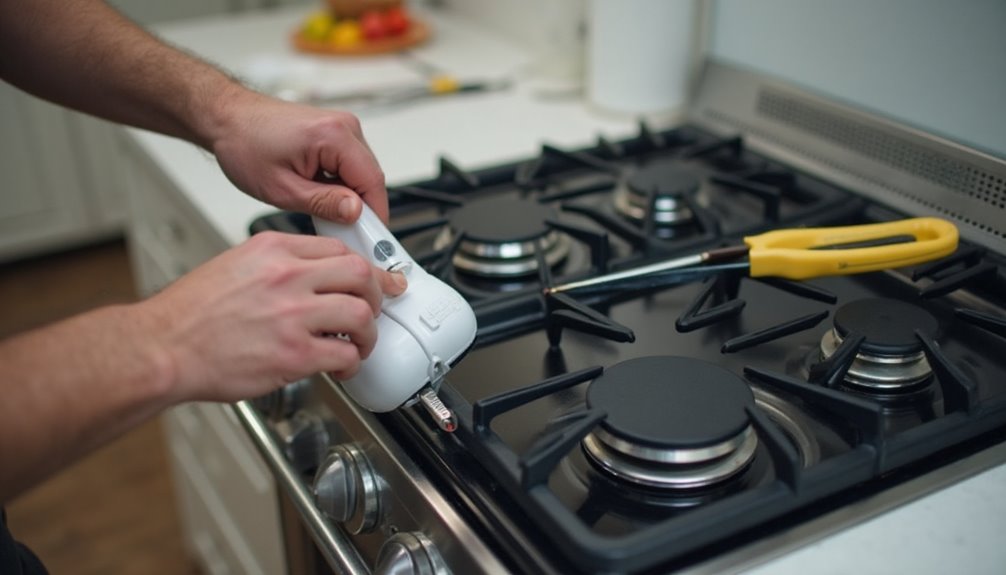
Once you’ve selected the right automatic shutoff device, proper installation becomes your next focus.
Most motion-sensing models mount above the stove, requiring clear line-of-sight to the cooking area, while heat-sensitive options connect directly to burner knobs or the power supply.
Position your device strategically – motion sensors need clear visibility, while heat detectors require direct connection to controls.
For above-stove placement, install the sensor 12-25 inches above the cooktop, centered for maximum coverage.
Avoid locations near windows, air vents, or areas with heavy foot traffic that might trigger false alarms.
If you’ve chosen a system that connects to your electrical panel, I strongly recommend professional installation.
DIY is appropriate for simpler models that use batteries or plug into standard outlets.
Remember to test your device regularly after installation to guarantee it’s functioning correctly and providing the protection your loved ones need.
Setup steps
After purchasing your automatic stove shutoff device, you’ll need to follow a clear setup process to verify proper functioning.
Most systems involve these key installation steps:
- Turn off power to your stove at the circuit breaker for safety.
- Mount the control unit according to manufacturer instructions, typically near the stove.
- Install required sensors – motion detectors mounted at eye level or heat sensors above burners.
- Connect the control unit to your home’s power supply.
- Test the system thoroughly, confirming it shuts off when unattended.
- Adjust sensitivity settings if available.
Remember that some systems require professional installation, especially those that connect to natural gas lines.
Always check if your model requires certified technicians to maintain warranty protection and verify proper functionality.
Costs and warranties
When budgeting for an automatic stove shutoff device, you’ll want to evaluate both the initial purchase price and potential installation costs.
Most basic models range from $150-300, while advanced systems with remote monitoring capabilities can cost $300-500.
Setting aside an additional $100-150 for professional installation is wise if you’re not comfortable with DIY electrical work.
Example budget
Understanding the costs involved in automatic stove shutoff devices can help you plan appropriately for your parents’ safety needs. When budgeting for these safety solutions, consider both the initial purchase cost and any installation fees if you’re not comfortable with DIY setup.
| Device Type | Average Cost | Installation |
|---|---|---|
| Basic timer | $40-70 | Self-install |
| Motion sensor | $100-200 | Self/Pro ($75) |
| Smart plugs | $35-80 | Self-install |
| Complete systems | $250-400 | Professional ($150) |
| Guardian system | $600-900 | Professional ($200) |
Many families find that the basic timer or motion sensor options provide excellent protection at a reasonable cost. For those with more complex needs or larger kitchens, investing in a complete system offers thorough protection. Remember that this investment directly contributes to your parents’ safety and your peace of mind.
Daily use and upkeep
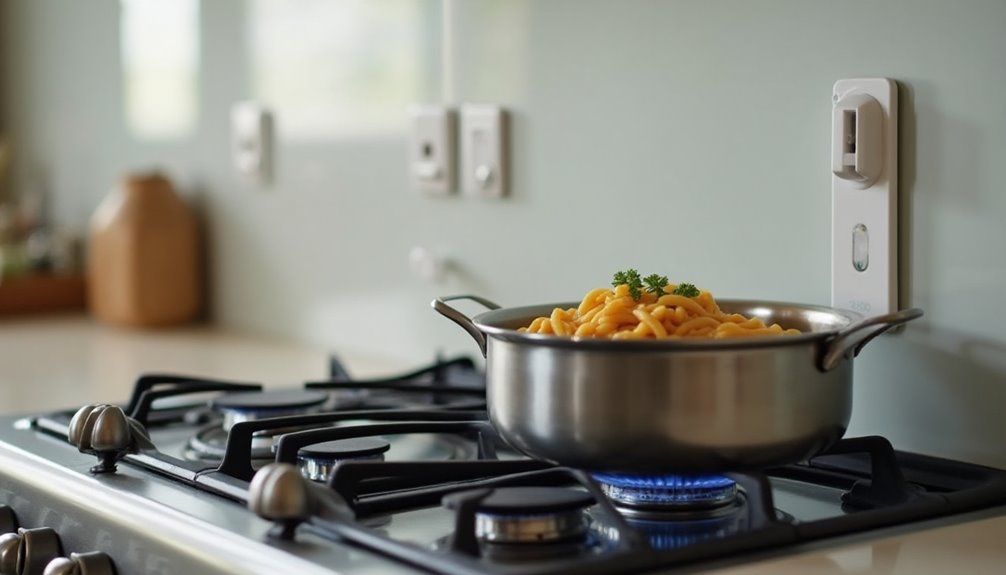
Since automatic stove shutoff devices serve as critical safety features in your parent’s home, maintaining them properly guarantees they’ll function when needed most. Most systems require minimal upkeep, but regular testing is essential to guarantee continued protection.
Monthly maintenance is straightforward: test the device by simulating a cooking scenario, check that all sensors remain in their proper positions, and wipe down external components with a damp cloth.
For ideal accessibility, keep the reset buttons and manual override features free from grease buildup and within easy reach.
Some models feature indicator lights showing operational status—make these visible by keeping them clean. If your parent has vision challenges, place contrasting colored tape near controls to improve accessibility.
Remember that even reliable devices need occasional battery replacements and sensor calibration to maintain their protective capabilities.
Safety tips and mistakes to avoid
While automatic stove shutoff devices provide excellent protection, they work best when paired with smart safety habits. Remember to check device batteries monthly and test functionality regularly.
Never disable or override safety features, even temporarily, as this defeats the entire purpose of having protection.
Common mistakes include installing devices incorrectly, ignoring manufacturer maintenance schedules, or forgetting to replace aging units. Some homeowners place too much faith in technology alone without maintaining basic kitchen safety practices.
For ideal protection, continue to use proper cooking techniques—never leave pots unattended, keep flammable items away from burners, and verify smoke detectors are working throughout the home. Additionally, implementing quarterly maintenance schedules for kitchen safety devices can significantly enhance overall safety measures.
These safety tips, combined with automatic shutoff technology, create multiple layers of protection for your loved ones when they’re cooking independently.
Alternatives and when not to use this product
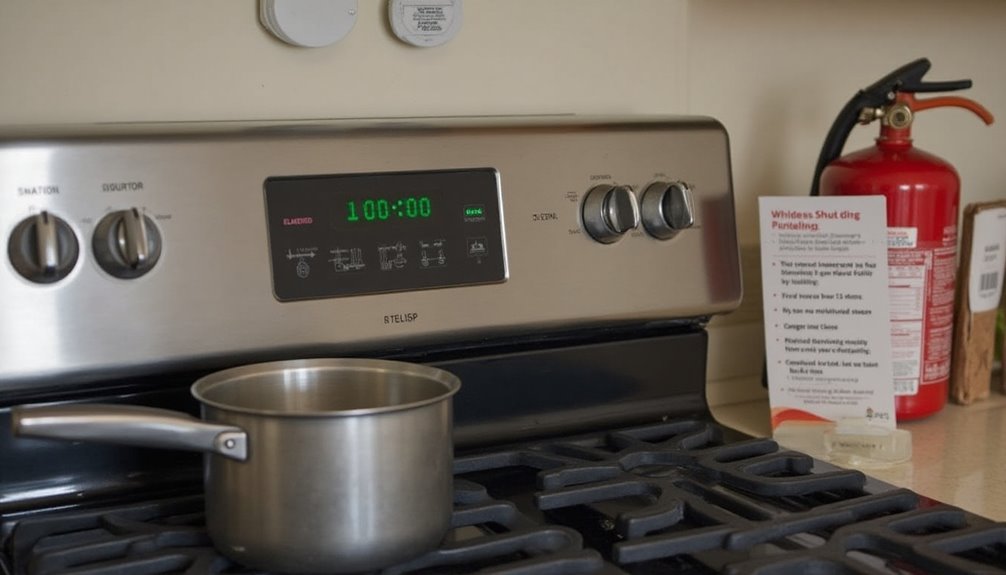
Automatic stove shutoffs aren’t the only solution for kitchen safety, and they’re not right for every situation. For seniors who still maintain good cognitive function and cooking habits, less intrusive options might provide adequate protection with greater comfort.
Consider these alternatives:
- Induction cooktops that heat only when compatible cookware is present
- Timer-based devices that alert rather than shut off
- Smart home systems that monitor kitchen activity
- Meal delivery services that reduce cooking frequency
Automatic shutoffs may not be appropriate when:
- Multiple household members use the stove regularly
- The senior strongly resists assistive devices
- Professional caregivers prepare most meals
- The existing stove can’t accommodate the device
Always assess each situation individually, balancing safety needs with maintaining independence and dignity. The best solution respects both safety concerns and personal preferences.
Frequently Asked Questions
Can These Devices Be Installed on Gas Stoves?
Yes, automatic shutoff devices can absolutely be installed on gas stoves.
Many models are specifically designed for gas cooktops, monitoring both motion and cooking time. Installation usually doesn’t require professional help—most devices connect to your gas line with simple tools.
When shopping, confirm the device explicitly states it’s compatible with gas stoves, as some are electric-only. You’ll need to take into account your specific stove model before purchasing.
Will the Device Shut off if Someone Is Actively Cooking?
No, properly designed automatic stove shutoff devices won’t interrupt active cooking.
They use motion sensors to detect when someone is present and engaged in the cooking process. The technology can distinguish between someone actively cooking versus a pot accidentally left unattended.
If you step away briefly to answer the phone, most devices include a timer feature that allows a reasonable absence before triggering shutdown, typically between 3-5 minutes.
Can These Devices Be Connected to Smart Home Systems?
Yes, many modern stove shutoff devices can integrate with smart home systems like Amazon Alexa or Google Home.
You’ll need to check specific model compatibility, but this feature allows you to monitor cooking status remotely through a smartphone app.
Some advanced units even send alerts when the stove is left on or automatically shut off based on customized settings.
This connectivity provides additional peace of mind for families supporting aging parents.
Do They Require Professional Installation or Can Homeowners Install Them?
Most automatic stove shutoff devices are designed for DIY installation.
You’ll typically just need to plug them in and follow some basic setup steps.
However, smart home connected models might need a bit more technical know-how.
If your parents have cognitive challenges or you’re uncomfortable with the installation, I’d recommend hiring an electrician.
It’s worth the peace of mind to guarantee everything’s working properly from day one.
How Do These Devices Affect Homeowner’s Insurance Premiums?
Many homeowners’ insurance carriers offer discounts for safety devices that prevent fires, including automatic stove shutoffs.
While specific premium reductions vary by company, you’ll typically see discounts of 2-5%.
Contact your insurance agent with device documentation to determine your eligibility.
Some carriers also offer senior-specific discounts when safety modifications are made.
It’s worth checking, as these savings can help offset the initial investment in these potentially life-saving devices.
Bottom Line
You’ve now discovered how automatic stove shutoff devices can transform kitchen safety in your home. By investing in this technology, you’ll protect yourself and your loved ones from the dangers of unattended cooking fires. Remember to choose a device that meets your specific needs, install it properly, and perform regular maintenance. With these precautions in place, you’ll enjoy greater peace of mind and independence in the kitchen.



